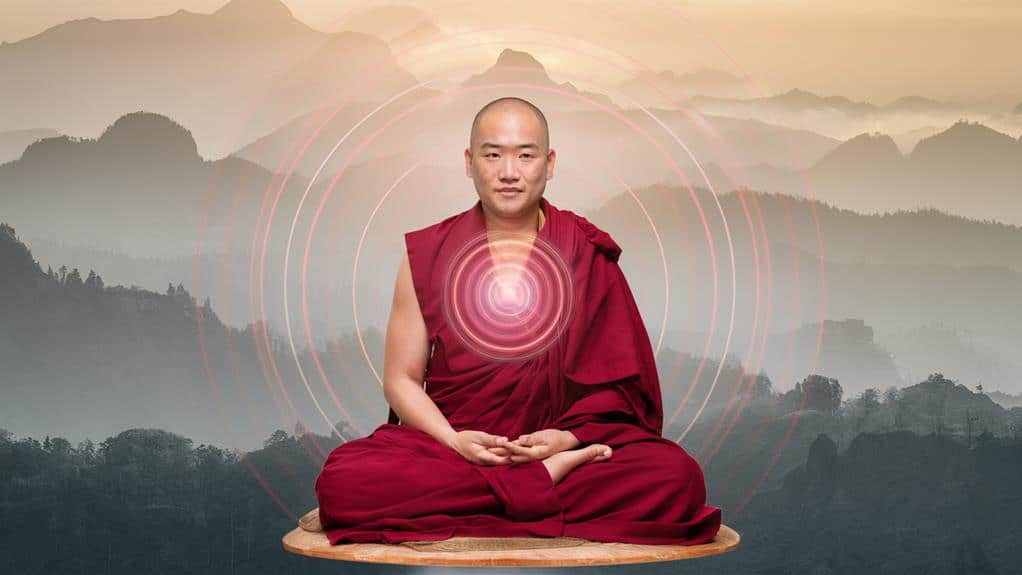7 Tibetan Buddhist Meditation Techniques
You’ve likely heard about meditation’s benefits, but you may not realize that Tibetan Buddhism offers some of the most sophisticated and time-tested techniques available. Whether you’re seeking inner peace, deeper insight, or greater compassion, these seven ancient practices can transform your relationship with both your mind and the world around you. From the foundational practice of Shamatha to the profound exchange of Tonglen, each method serves as a unique gateway to understanding yourself and others. Let’s explore these powerful techniques that have guided practitioners toward enlightenment for over two thousand years.
Shamatha: The Peaceful Abiding

Settling into a quiet space, practitioners of Shamatha meditation focus on achieving a state of mental calmness and stability.
You’ll discover that this foundational practice invites you to rest your attention on a chosen object – often the breath – while allowing thoughts to arise and dissolve without attachment. As you cultivate this singular focus, you’re developing what’s known as “peaceful abiding,” a state where your mind naturally settles like still water.
Through consistent practice, you’ll notice the gradual quieting of mental chatter that typically clouds your awareness. The technique isn’t about forcing thoughts away; instead, you’re learning to maintain unwavering attention while acknowledging distractions without becoming entangled in them.
As your practice deepens, you’ll experience moments of profound clarity where the boundary between observer and observed begins to dissolve.
In the Tibetan tradition, this practice serves as an essential foundation for more advanced meditation techniques.
You’re not just training your mind to focus – you’re cultivating a relationship with your own consciousness, creating a stable platform from which deeper insights and realizations can naturally emerge.
Vipassana: Clear Seeing
While Shamatha cultivates a stable mind, Vipassana meditation takes you deep into the nature of reality itself. Through this profound practice, you’ll examine your thoughts, emotions, and physical sensations with unwavering awareness, discovering their impermanent and interconnected nature.
As you penetrate the layers of experience, you’ll begin to see how your mind constructs reality moment by moment. In Vipassana practice, you’re invited to witness the ever-changing flow of phenomena without attachment or aversion.
You’ll observe how sensations arise and pass away, how thoughts emerge and dissolve, and how emotions surge and recede like waves on an ocean. This intimate observation reveals the three marks of existence: impermanence, unsatisfactoriness, and non-self.
As your insight deepens, you’ll recognize that what you’ve considered solid and permanent is actually fluid and transient. Through sustained practice, you’ll develop wisdom that transcends intellectual understanding.
The boundaries between observer and observed begin to blur, and you’ll experience directly the empty nature of all phenomena. This transformative insight liberates you from the grip of delusion and leads to profound freedom from suffering.
Tonglen: Giving and Taking

Tonglen stands out from among the most powerful compassion practices in Tibetan Buddhism. In this profound meditation, you’ll work directly with suffering and happiness, learning to transform your relationship with both. As you breathe in, you’ll visualize taking in the pain and distress of others as a dark, heavy smoke; as you exhale, you’ll send out light, love, and healing to all beings.
This practice challenges your habitual tendency to avoid discomfort and cling to pleasure. When you encounter someone’s suffering, instead of turning away, you’ll breathe it in with the wish to free them from their pain. You’re not just imagining this exchange – you’re training your heart to stay open in the face of difficulty.
Through Tonglen, you’ll discover that what you once feared can become a gateway to profound connection. You’ll find that this practice dissolves the artificial boundary between self and other, revealing the interconnected nature of all beings.
As you continue, you’ll notice your capacity for compassion expanding naturally, and you’ll experience firsthand the paradoxical truth that giving brings more joy than receiving.
Nine-Round Breathing Exercise
Through precise breath control, the Nine-Round Breathing Exercise cleanses and balances your subtle energy channels. As you sit in meditation posture, you’ll visualize three channels: a white central channel and two side channels – red on the right and blue on the left. These pathways carry your life force, or prana, throughout your body’s energetic system.
Begin by closing your right nostril and breathing in through the left, visualizing white light entering the left channel. Hold briefly, then exhale through your right nostril, releasing gray smoke that represents negativity and blockages. You’ll repeat this pattern three times, then switch sides for another three rounds, breathing in through the right and out through the left.
Finally, you’ll complete three rounds breathing through both nostrils, focusing on the central channel. As you progress through each round, you’re not just moving air – you’re purifying emotional and mental obstacles while harmonizing the masculine and feminine energies within.
Your breath becomes a sacred tool, transforming scattered thoughts into clarity and bringing your body’s subtle energies into perfect equilibrium.
Walking Meditation Practice

Walking meditation practitioners discover a powerful mindfulness bridge between seated practice and daily life. As you engage in this sacred form of movement, you’ll find yourself cultivating awareness with each deliberate step, transforming an ordinary walk into a profound spiritual journey.
You’ll notice how your feet connect with the earth, creating a rhythmic dance between body and ground that anchors you firmly in the present moment.
Begin by choosing a quiet path where you won’t be disturbed, preferably 20-30 steps in length. You’ll want to walk at about half your normal pace, coordinating your breath with your movement.
As you lift each foot, feel the subtle shift in balance, the gentle transfer of weight, and the miraculous complexity of muscles and bones working in harmony. Let your arms hang naturally at your sides, and keep your gaze soft, focused about six feet ahead.
If your mind wanders, don’t judge yourself – simply return your attention to the sensations of walking. You’re learning to carry meditation’s gifts beyond the cushion, weaving mindfulness into life’s everyday movements.
Contemplating Impermanence
Awareness of life’s ephemeral nature lies at the heart of Buddhist contemplation on impermanence. When you engage in this meditation, you’ll observe how each moment flows into the next, leaving only traces in your consciousness before dissolving into memory. Notice how your breath, thoughts, and sensations continuously shift and transform, never remaining static.
To deepen your practice, you’ll want to expand your awareness beyond personal experience. Watch clouds morphing in the sky, observe leaves changing colors through seasons, and witness how your relationships evolve over time. You’re training your mind to recognize that nothing stays fixed – not your body, your thoughts, or the world around you.
As you cultivate this understanding, you’ll find that accepting impermanence doesn’t lead to despair but to profound liberation. You’ll begin to hold your experiences more lightly, knowing they’re temporary visitors in your consciousness.
This recognition helps you release attachment to outcomes and embrace life’s natural flow. Through this contemplation, you’re developing wisdom that transforms your relationship with change from resistance to acceptance.
Compassion Meditation

Understanding impermanence opens the door to compassion, as we recognize the shared experience of change and suffering. Within this awareness, you’ll find a profound invitation to cultivate loving-kindness for all beings who, like you, navigate life’s uncertainties and challenges.
You begin compassion meditation by focusing on someone you naturally care for, allowing your heart to fill with warmth and genuine concern for their wellbeing. As you deepen your practice, you’ll gradually expand this circle of care to include neutral persons, challenging relationships, and ultimately all sentient beings.
Through visualization, you can imagine their joys and sorrows, their hopes and fears, creating an authentic connection that transcends ordinary boundaries.
In advanced stages, you’ll learn to transform your relationship with suffering itself. Rather than turning away, you’ll develop the capacity to stay present with pain – both yours and others’ – while maintaining a spacious, caring awareness.
This practice isn’t about forcing emotions but rather creating conditions where natural compassion can emerge and flourish, like a lotus growing from muddy waters into pristine beauty.









